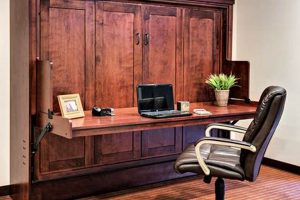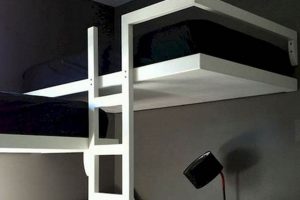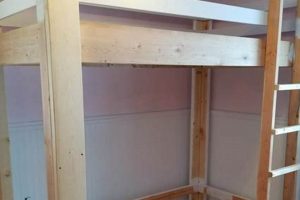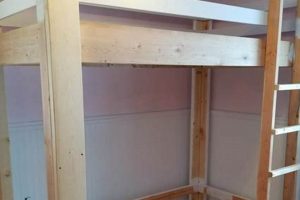A self-constructed sleeping platform designed for a young individual offers a personalized and often cost-effective alternative to commercially manufactured furniture. This project involves building a bed frame, typically from wood, tailored to the child’s specific needs and the available space. Such creations can range from simple, low-to-the-ground platforms to more elaborate designs incorporating storage or playful elements.
The advantages of this approach include significant cost savings, the ability to customize dimensions and features, and the satisfaction of creating a unique piece of furniture. Historically, crafting furniture at home was a necessity; today, it represents a conscious choice to embrace creativity, resourcefulness, and potentially more sustainable practices. It enables parents or guardians to ensure the bed is constructed with non-toxic materials and built to a higher standard of safety, suited to the child’s age and developmental stage.
The following sections will detail essential considerations for planning, designing, and executing such a project, including selecting appropriate materials, ensuring structural integrity, and incorporating safety features. The focus will be on providing practical guidance for creating a durable and functional sleeping space for a child.
Essential Considerations for a Self-Made Bed
Constructing a sleeping space for a young one requires careful planning and execution. The following guidelines offer practical advice to ensure a safe, durable, and age-appropriate outcome.
Tip 1: Material Selection: Opt for lumber that is both strong and free from harmful chemicals. Kiln-dried hardwoods, such as maple or poplar, offer stability and durability. Ensure any finishes used are non-toxic and specifically designed for children’s furniture.
Tip 2: Precise Measurements: Accurate dimensions are crucial. Measure the mattress intended for use and add appropriate clearance for bedding. Consider the child’s growth trajectory to avoid needing to replace the structure prematurely.
Tip 3: Structural Integrity: Robust joinery is paramount. Employ techniques such as mortise and tenon, dowels, or pocket screws, reinforced with wood glue. Reinforce corners with metal brackets for added stability, particularly in designs intended for active children.
Tip 4: Safety Rails and Barriers: For younger children, install secure side rails to prevent falls. Ensure these rails are appropriately spaced to prevent entrapment. Adhere to established safety standards for crib and toddler bed rail heights.
Tip 5: Smooth Surfaces and Rounded Edges: Sand all surfaces thoroughly to eliminate splinters. Round over sharp edges with a router or sandpaper to minimize the risk of injury. Inspect the completed project meticulously for any potential hazards.
Tip 6: Weight Capacity Considerations: Account for the child’s current weight, as well as anticipated growth. Design the bed frame to withstand significantly more weight than the child’s current mass to ensure long-term durability.
Tip 7: Proper Ventilation: Allow for adequate airflow beneath the mattress to prevent moisture buildup and mold growth. Slatted platforms or perforated bases are preferable to solid surfaces.
These measures contribute to a secure and lasting sleeping environment. Prioritizing safety and employing sound construction practices are essential elements in the process.
The subsequent discussion will delve into design considerations and aesthetic options, allowing for the creation of a space that is both functional and appealing.
1. Safety Standards and DIY Child's Beds
The construction of a sleeping platform for a child necessitates strict adherence to established safety standards. These guidelines are paramount in mitigating potential hazards and ensuring the well-being of the occupant. Deviation from these standards can result in serious injury or even fatality. Therefore, a comprehensive understanding and meticulous application of these regulations are critical to the success of any such project.
- Rail Height and Spacing
Safety standards dictate specific dimensions for the height and spacing of side rails. Insufficient rail height can lead to falls, while excessive spacing can pose a risk of entrapment. These dimensions are carefully determined based on the average size and developmental stage of children within specific age ranges. Compliance with these standards minimizes the likelihood of accidents associated with falling out of the bed or becoming wedged between the rails.
- Material Non-Toxicity
Regulations regarding material safety prohibit the use of toxic substances in children’s furniture. This includes paints, finishes, and adhesives that may contain lead, phthalates, or other harmful chemicals. Children are particularly vulnerable to the effects of these substances due to their tendency to put objects in their mouths. Utilizing certified non-toxic materials is essential to prevent potential health problems associated with exposure to harmful chemicals.
- Structural Integrity and Stability
Safety standards address the structural integrity and stability of the bed frame. This includes requirements for load-bearing capacity, joint strength, and overall stability. A poorly constructed frame can collapse under the child’s weight, resulting in injury. Adhering to these standards ensures that the bed is capable of withstanding the stresses of normal use and remains stable even when subjected to movement or activity.
- Elimination of Sharp Edges and Protrusions
Safety regulations mandate the elimination of sharp edges and protruding hardware that could pose a laceration or puncture hazard. All edges should be rounded or beveled, and any exposed fasteners should be recessed or covered. This reduces the risk of accidental cuts, scrapes, and other injuries associated with contact with sharp or protruding components.
These facets of safety standards are not merely suggestions; they are critical elements that must be incorporated into the design and construction of any self-made sleeping structure for a young person. While the appeal of customization and cost savings may be significant, they must never outweigh the imperative to provide a safe and secure sleeping environment. Thorough research and diligent adherence to these established guidelines are essential to ensuring a successful and, above all, safe outcome.
2. Material Non-Toxicity and DIY Child's Beds
The selection of materials for a self-constructed sleeping platform directly impacts the health and safety of the child using it. Commercial products often contain volatile organic compounds (VOCs) found in paints, adhesives, and pressed wood products. These substances can off-gas over time, contributing to indoor air pollution and potentially triggering respiratory issues, allergies, or other adverse health effects, particularly in young children. Therefore, prioritizing non-toxic materials in a DIY approach offers a significant advantage.
Examples of safer material choices include solid wood from sustainable sources, finished with certified non-toxic paints or sealants. Water-based finishes, milk paints, and beeswax polishes represent viable alternatives to conventional products containing harmful chemicals. Similarly, when constructing mattresses or bedding, opting for organic cotton, wool, or natural latex minimizes exposure to pesticides, synthetic dyes, and flame retardants commonly found in mass-produced items. By carefully selecting materials, individuals can reduce or eliminate the child’s exposure to potentially harmful substances, creating a healthier sleeping environment.
Ensuring material non-toxicity presents challenges, requiring careful research and potentially increasing material costs. However, the long-term health benefits associated with reduced exposure to harmful chemicals often outweigh these considerations. The proactive approach to material selection in a self-constructed bed directly contributes to a safer and healthier environment, emphasizing the practical significance of prioritizing material non-toxicity. This consideration directly affects the quality and safety, integral to sleeping solutions for children.
3. Size Customization
The capacity to modify dimensions is a pivotal advantage inherent in the self-directed creation of sleeping structures for young individuals. This customization addresses the limitations of standard, commercially available options, enabling the creation of a bed precisely tailored to the child’s individual needs, spatial constraints, and developmental stage. This adaptability directly impacts both the functionality and long-term suitability of the structure.
- Adapting to Room Dimensions
Commercially available beds adhere to standard sizes that may not optimally utilize the available space within a given room. Size customization allows for the construction of a bed that maximizes usable area, particularly valuable in smaller bedrooms. For instance, a narrow or unusually shaped room might benefit from a custom-built bed with a shorter length or non-standard width, optimizing floor space for play or other activities.
- Accommodating Child’s Growth
While standard bed sizes cater to broad age ranges, individual children grow at varying rates. Size customization allows for a bed length that precisely matches the child’s height, providing adequate support and preventing discomfort. A taller child might require a longer bed than typically recommended for their age, ensuring a more restful and ergonomic sleeping experience.
- Integrating Storage Solutions
Customized dimensions can facilitate the seamless integration of storage solutions directly into the bed frame. Under-bed drawers, built-in shelving, or even raised platforms with storage compartments can be incorporated to maximize space utilization and minimize clutter. This is particularly beneficial in smaller living spaces where dedicated storage furniture might be impractical.
- Meeting Specific Needs
Certain medical conditions or physical limitations may necessitate specific bed dimensions or features. For example, a child with mobility issues might require a lower bed height for easier access. Similarly, a child with sensory sensitivities might benefit from a bed with enclosed sides or a specific mattress type, accommodated through customized dimensions and construction.
The ability to modify dimensions represents a core benefit of the self-directed approach, allowing for the creation of a sleeping space that is not only functional and comfortable but also optimally adapted to the child’s unique circumstances and the constraints of their environment. This level of personalization surpasses the limitations of mass-produced alternatives, contributing to a more suitable and enduring sleeping solution.
4. Structural Robustness
Structural robustness, in the context of a self-constructed sleeping platform for a child, denotes the capacity of the assembly to withstand anticipated loads and stresses without undergoing failure or deformation. This characteristic is not merely desirable but fundamentally essential to the safety and longevity of the bed. A lack of structural robustness directly translates to an increased risk of collapse, component failure, or instability, potentially leading to significant injury. The child’s weight, combined with the dynamic forces generated by movement, jumping, or playing on the bed, imposes considerable stress on the frame, joints, and supporting elements. Therefore, the design and execution must prioritize structural integrity to ensure a secure and stable sleeping environment.
The practical implications of structural robustness are manifest in several key aspects of the design and construction process. Material selection plays a crucial role; opting for hardwoods, such as maple or oak, over softer woods provides greater strength and resistance to deformation. Joint design is equally critical. Employing robust joinery techniques, such as mortise and tenon, dovetail, or reinforced screw connections, distributes stress effectively and prevents joint failure. Reinforcement of critical areas, such as corners and load-bearing supports, through the use of metal brackets or gussets, enhances the overall structural integrity. For example, a frame constructed with insufficient joinery or inadequate support members may exhibit excessive flexing or wobbling, indicating a lack of robustness and posing a potential safety hazard. A robust design, on the other hand, will exhibit minimal deflection under load and maintain its structural integrity over time.
In summary, structural robustness is a non-negotiable requirement in the creation of a sleeping structure for a child. Its absence compromises safety and diminishes the lifespan of the bed. Prioritizing robust design, employing appropriate materials and construction techniques, and carefully considering load-bearing capacity are essential steps in ensuring a secure and durable sleeping environment. The challenges associated with achieving adequate structural robustness underscore the importance of thorough planning, meticulous execution, and a comprehensive understanding of structural principles.
5. Age Appropriateness
Age appropriateness is a foundational consideration in the conception and execution of a self-constructed sleeping structure for a young individual. The developmental stage and physical capabilities of the child directly dictate the necessary safety features, dimensions, and overall design. Neglecting this critical element can result in a sleeping environment that presents significant safety risks or fails to adequately support the child’s needs. For example, a toddler requires safety rails to prevent falls, while an older child may necessitate a sturdier frame capable of supporting increased weight and activity. A bed designed without regard for age appropriateness can create hazards that are easily avoidable with proper planning.
Practical examples of age-appropriate adaptations include adjusting the bed height to facilitate independent entry and exit for older children, while ensuring the height remains low enough to minimize fall risks for younger ones. The selection of mattress firmness is another key consideration, as infants and toddlers require firmer mattresses to reduce the risk of sudden infant death syndrome (SIDS), while older children may benefit from softer, more supportive mattresses. Furthermore, the incorporation of design elements that promote age-appropriate play and development, such as integrated storage for toys or books, can enhance the functionality and appeal of the bed. A bed constructed for a five-year-old will differ significantly from one designed for a fifteen-year-old, reflecting the evolving needs and capabilities of the child. The size of bed should be proportional to their age and the room size.
In conclusion, prioritizing age appropriateness is paramount to ensuring the safety, functionality, and suitability of a self-constructed sleeping structure. Challenges may arise in anticipating future needs as the child grows, necessitating a design that allows for modifications or adaptations over time. By carefully considering the child’s developmental stage, physical capabilities, and individual needs, it becomes possible to create a sleeping environment that promotes their well-being and fosters healthy development, ensuring the bed remains a safe and comfortable space for years to come.
6. Design Flexibility
The concept of design flexibility, when applied to the self-directed construction of a child’s sleeping platform, represents a significant advantage over commercially manufactured alternatives. It allows for the creation of a customized solution that addresses specific spatial constraints, aesthetic preferences, and functional requirements, thereby enhancing the overall utility and suitability of the bed.
- Adaptation to Spatial Constraints
Conventional beds adhere to standardized dimensions, which may not optimally integrate within uniquely shaped or dimensioned rooms. Design flexibility allows for the creation of sleeping structures that precisely conform to the available space, maximizing usable floor area. An example is a loft bed designed to fit under a sloped ceiling, or a corner bed that efficiently utilizes an otherwise underutilized area. This adaptability is particularly relevant in smaller living spaces where efficient space utilization is critical.
- Integration of Personalized Aesthetic Elements
Commercially produced beds often present limited aesthetic options, potentially clashing with existing room dcor or failing to reflect the child’s individual preferences. Design flexibility empowers the creator to incorporate specific color schemes, patterns, and thematic elements that harmonize with the overall aesthetic of the room or cater to the child’s personal interests. This might include incorporating specific cartoon characters, geometric patterns, or natural wood finishes to create a visually appealing and personalized sleeping environment.
- Incorporation of Integrated Functional Features
Standard beds typically provide only the basic function of sleep. Design flexibility enables the integration of additional functional features directly into the bed frame. Examples include built-in storage compartments, bookshelves, desks, or even integrated play areas. This integration of multiple functions optimizes space utilization and enhances the overall practicality of the structure. A bed with integrated storage drawers, for instance, eliminates the need for separate storage furniture, freeing up valuable floor space.
- Accommodation of Evolving Needs
Children’s needs and preferences evolve rapidly over time. Design flexibility allows for the creation of a bed that can be readily modified or adapted to accommodate these changing requirements. A simple platform bed can be easily converted into a loft bed as the child grows, or decorative elements can be swapped out to reflect evolving aesthetic tastes. This adaptability extends the lifespan of the bed and reduces the need for frequent replacements.
These facets of design flexibility underscore the significant benefits associated with self-directed construction. By embracing this adaptability, individuals can create a sleeping structure that is not only functional and safe but also uniquely tailored to the specific needs, preferences, and circumstances of the child and their environment. The increased satisfaction and practicality arising from a highly customized solution further enhance the value of the DIY approach.
7. Cost Effectiveness
The economic advantage inherent in the self-directed construction of a sleeping platform for a young individual is a primary motivator for many individuals. Compared to commercially manufactured alternatives, a do-it-yourself approach can yield significant cost savings, provided that careful planning and execution are employed. This cost-effectiveness is influenced by several factors relating to materials, labor, and design considerations.
- Reduced Material Expenditure
The selection of materials constitutes a substantial portion of the overall cost. By sourcing lumber directly from sawmills or utilizing reclaimed materials, individuals can significantly reduce expenditures compared to purchasing pre-fabricated components from retail outlets. Furthermore, the elimination of markups associated with commercial manufacturing and distribution contributes to lower material costs. The precise material savings varies depending on the complexity of the design and the availability of affordable resources.
- Elimination of Labor Costs
A significant cost component of commercially produced furniture is the labor involved in its assembly. By undertaking the construction process, the individual eliminates these labor costs entirely. The value of this saved labor is dependent upon the individual’s skill set and the time commitment required. This aspect provides not only monetary savings but also the personal satisfaction derived from creating a functional object. However, it necessitates the investment of time and effort to complete the project successfully.
- Customization and Value Enhancement
The ability to customize the design allows for the optimization of material usage and the integration of features that enhance the long-term value of the bed. For example, incorporating storage solutions directly into the bed frame can eliminate the need for separate furniture pieces, resulting in additional cost savings and improved space utilization. Customization also allows for the selection of durable materials and construction techniques, ensuring a longer lifespan compared to mass-produced alternatives.
- Life Cycle Cost Considerations
While the initial investment in materials for a DIY project may be comparable to lower-end commercially available options, the long-term cost effectiveness stems from increased durability and potential for repair. A well-constructed bed, utilizing quality materials, is less likely to require replacement within a short timeframe. Furthermore, the ability to repair or modify the bed as needed extends its lifespan and reduces the overall cost of ownership. This contrasts with cheaper, mass-produced beds that often have a shorter lifespan and limited repair options.
The various aspects of “Cost effectiveness” are very benificial for using “diy childs bed”, and provides cost savings, customization options, and enhances its long-term utility and value. Careful planning, material sourcing, and sound construction techniques are essential to realize the full economic potential of this approach. A well-executed DIY child’s bed represents a financially prudent and personally rewarding alternative to commercially produced furniture.
Frequently Asked Questions About DIY Child’s Beds
This section addresses common inquiries regarding the self-directed construction of sleeping platforms for children. It aims to provide concise and factual answers to pertinent questions.
Question 1: Is constructing a sleeping platform for a child a safe undertaking?
Safety is paramount. Adherence to established safety standards regarding rail height, spacing, and material non-toxicity is crucial. Structural integrity must be rigorously assessed to prevent collapse or instability.
Question 2: What materials are most suitable for a DIY project of this nature?
Hardwoods, such as maple or oak, offer superior strength and durability. Finishes must be certified non-toxic and specifically formulated for children’s furniture. Avoid materials containing volatile organic compounds.
Question 3: How can the project be adapted to accommodate limited space?
Customized dimensions allow for the construction of a bed that maximizes usable space within a given room. Consider loft beds or platform beds with integrated storage solutions to optimize space utilization.
Question 4: What tools are essential for this type of project?
Essential tools include a saw (circular or hand saw), drill, sander, measuring tape, level, and appropriate fasteners. Safety equipment, such as eye protection and a dust mask, is also necessary.
Question 5: How does the cost compare to purchasing a commercially manufactured bed?
A self-directed construction can yield significant cost savings, particularly when utilizing reclaimed materials or sourcing lumber directly. However, the investment of time and labor must be factored into the overall cost assessment.
Question 6: How can the bed be designed to accommodate the child’s growth?
Design the bed with modular components that can be adapted or expanded as the child grows. Consider adjustable bed rails or the option to convert a smaller bed into a larger one.
These responses offer a starting point for understanding the key considerations involved in the self-directed construction of a child’s sleeping platform. Comprehensive research and careful planning are essential for a successful outcome.
The subsequent discussion will explore potential design ideas and inspirational concepts for creating a unique and functional sleeping space.
DIY Child’s Bed
The preceding discussion has explored various facets of the “diy childs bed” project, emphasizing safety standards, material selection, structural integrity, age appropriateness, design flexibility, and cost-effectiveness. It has highlighted the necessity of rigorous planning and meticulous execution in creating a sleeping platform that is both secure and functional for a young individual. These elements must be carefully considered to ensure a successful outcome.
The pursuit of a “diy childs bed” requires a comprehensive understanding of construction principles and a commitment to prioritizing the child’s well-being above all else. By adhering to established safety guidelines and employing sound building practices, it is possible to create a personalized and durable sleeping space. The information presented serves as a guide for those undertaking this endeavor, underscoring the importance of informed decision-making and responsible implementation. The long-term benefits of a well-executed project are significant, providing a safe, comfortable, and customized sleeping environment for the child’s developmental years.


![DIY Truck Bed Rack: Build Your Own Bed Rack [Plans] The DIY Hub: Creative Crafts, Repairs & Life Hacks DIY Truck Bed Rack: Build Your Own Bed Rack [Plans] | The DIY Hub: Creative Crafts, Repairs & Life Hacks](https://craftingdiycenter.com/wp-content/uploads/2025/07/th-2452-300x200.jpg)




